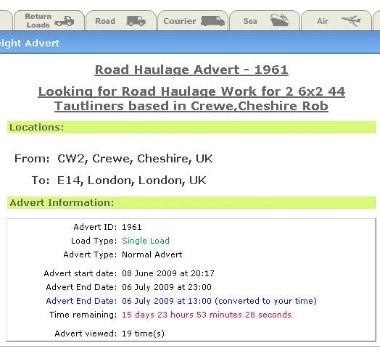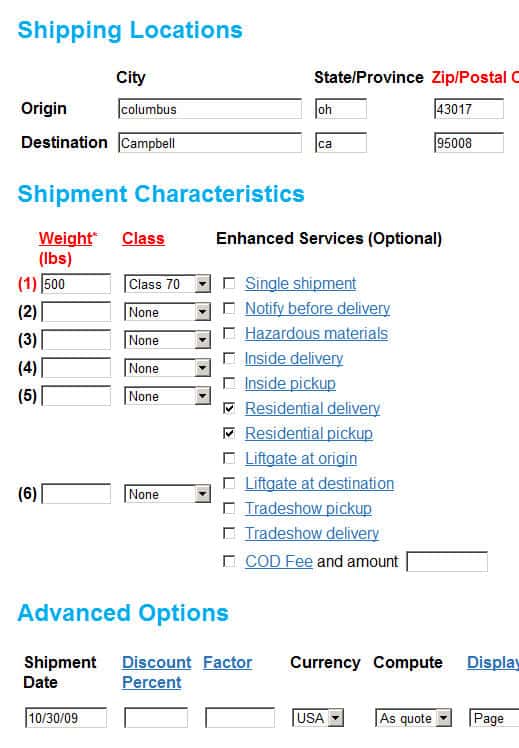How to Best Understand Freight Broker Marketplaces
Executive Summary
- What is a Private Fleet Freight Broker Marketplace Conceptually?
- Our Freight Broker Marketplaces Necessary?
- Freight Broker Web-Based Boards
- Would a Freight Load Board / Marketplace that Focused on Private Fleet Backhauls be a Good Idea?
- The History of Technology Marketplaces.
- A Comparison of Freight Tendering Marketplaces.
- The Real Need for Tendering Marketplaces and Freight Load Boards
- A Lower Volume Solution for Freight Load Boards
- A Higher Volume Solution for Freight Load Boards

Introduction
This article originated from an analysis of how outsourced transportation had been oversold for quite some time. One of the major benefits of outsourced transportation is that the shipping company can use the fact that it moves much more freight than most private fleets to move freight in both directions and reduce the number of deadhead miles. This is, in fact, probably the most compelling benefit of outsourced transportation. However, the assumption has always been that the freight must be within the carrier’s network for this efficient allocation of transportation resources to take place. However, is this the case?
What Is Required of a Freight Broker Load Board?
First, a private carrier must apply to operate as a for-hire carrier, requiring filing legal documentation and keeping rates on file with the state. They can use a standard freight carriage contract, or they use an individual service broker. They may have to use the freight contract employed by the broker. In fact, according to Trucking Partners, around 53% of private fleets are registered as for-hire carriers. Some percentage of the other 47% also carry solicited freight through what is essentially a loophole called trip-leasing, where a private fleet truck can run under the authority of a common carrier for a “trip.” It is also recognized that many private fleets are very active in soliciting freight for their backhauls.
In fact, roughly 70% of private fleets sell enough of their capacity to other customers that they can run their private fleet as a revenue center. However, on the other hand, some private fleets can become obsessed with getting profits from the private fleet, as is noted in this quote.
“Many private fleets spread themselves too thin in the quest for the attraction of revenue-producing freight. They send their equipment all over the place and forget to provide the quality of service expected by their parent company. The successful private fleets that exercise for-hire options solicit business within existing traffic lanes. In other words, the for-hire option is simply supplemental to private operators.”
Trucking Partners brings up the following good points that a private fleet needs to ask itself:
- Can drivers and equipment be delayed long enough to accommodate the pickup and delivery of backhaul loads?
- Is the equipment suitable for the implementation of a backhaul program?
- Do you have a good handle on your costs? – You need to understand the impact of providing “for-hire” activity on your operation regarding equipment delays, out-of-route miles, drivers’ hours of service, etc.
- Do you have the ability to solicit freight? – It’s a competitive market out there, and transportation won’t just appear because you want to fill an empty lane. Your services must be sold and coordinated . . . That’s our job!
Therefore it’s a trade-off going for common carriage freight. However, when it comes to managing for-hire freight, there are companies like Simon Transport that can administer the process of getting freight for backhauls. Therefore, this does not have to be performed by the in-house transportation department necessarily. Interestingly as recently as the 1980s, it was not legal for private fleets to haul freight for companies other than their parent company (most likely due to legislation introduced by the lobbyists for common carriers). Furthermore, those who contract out their private fleet or solicit freight for backhauls only report a cost reduction of 10% per mile.
Freight Broker Web-Based Boards
Freight broker web-based boards are common at this point. One which I discussed in the previous article was The SuperBoard, which is one of the biggest. However, most of them come across as amateurish. It’s probably not a good thing to have many web boards as this means the companies looking for trucks or private fleets looking for loads have to search multiple sites, which is inefficient. In fact, the Internet-based freight broker information sites seem underdeveloped, and I would not at all be surprised if freight brokering still very much relied upon personal relationships, phone calls, and emails. However, this true of freight load boards generally and does not say anything about the options available to private fleets versus common carriers.
Freight Load Boards Focused on a Private Fleet Backhauls?
Interestingly I was not able to find many freight load boards online that focused on private fleets. I did find a freight broker that focused on private fleets called Private Fleet Backhaul (PFBH). According to their website
“PFBH will move 23,000+ loads in 2011 via private/dedicated fleets, with revenue that will place us in the top 5% of freight brokerages nationwide.”
Backhaul Direct has a very slick site and is clearly focused on filling backhauls, although it is not directed towards private fleets. However, this is little reason a private fleet could not sign up for this service.
What Happened to the Technology Initiated Freight Revolution?
Let us take a walk down memory lane for marketplaces generally, way back to 1998-1999.
i2 Technologies was the number one supply chain vendor, and their management had seen fit to come out with a new concept based on information sharing and the web called TradeMatrix. To explain all of what TradeMatrix would take, more than one article. However, the basic idea was that i2 would create some marketplaces where supply chain information was to be exchanged, allowing a more integrated system of supply chain management to result. i2 introduced FreightMatrix, directed towards the transportation, warehousing, and third-party logistics areas of the supply chain.
Of all the TradeMatrixes, FreightMatrix is one of the few to survive, and its website can be found at https://www.freightmatrix.com.
Brochureware and Freight Load Boards
What you will notice about the site is although it talks a lot about advanced supply chain topics and software as a service, the site is nothing more than brochureware and had no way to open an account or experience the service offering. Once you begin to look under the surface, it is simply a front end for i2’s legacy transportation management product called TM, along with probably a few other products that add minimal functionality.
The problem with i2’s vision of TradeMatrix in general and FreightMatrix is they, as with many of the other major supply chain vendors, never really got the web. Their approach was to use the web to entice customers to sign on for what amounted to the same software model they had been offering for a while.
Tendering in SAP
SAP’s TPVS: transportation planning and vehicle scheduling have functionality that supports freight tendering. TPVS or TM interacts individually with different carriers allowing them to respond. This is not a marketplace offering.
SAP TPVS
TPVS transportation tendering functionality is not broadly used.
- Setting up these one-to-one integrations is expensive and time-consuming.
- SAP TM is exorbitantly priced and a low-quality application. It is priced far too high for its target market.
It also discriminates against smaller transportation providers who may not invest in the systems that the larger carriers can afford due to their scale economies. This reduces the choice of providers available to the transportation customer.
The Real Need for Tendering Marketplaces and Freight Load Boards
The need for marketplaces is real. However, instead of being implemented as a closed system as proposed by i2, the marketplaces need to be open and allow various buyers and sellers to participate. FreightTender is one such company/site. Below, the screenshot shows how easy it is to sign up. We created a dummy account ourselves.
It is easy to see freight advertisements.
A Low Volume Solution for Freight Load Boards
What became apparent immediately is how few listings there were. FreightTender’s website is easy to use and well done, so why the lack of volume? We also searched for freight tending software and did not find very many companies offering this software.
So the question we have is, “why not?” This is an obvious excellent use of information technology, yet the industry is not caught on to the idea. MercuryGate is the leader in providing independent integrated TMS and freight tendering for medium to higher volume shippers.
A Higher Volume Solution for Freight Load Boards
A website that is not integrated into the tendering system may be effective for small freight volumes, but it will not be efficient for large volumes. For this, I contacted the leader in integrated transportation management systems with freight tendering. This company is called MercuryGate. They sit at the crossroads of shippers, the freight broker, and 3PLs. Their transportation management solution is already connected to their load tendering system, which has many transportation companies already integrated into the system. This allows a new customer to be brought up and integrated with the carrier systems just a few weeks from the initial request to add the shipper to the system.
Moving to a system like this allows for far less manual intervention in the process of putting freight out to bid. This allows a tender to be sent to a huge number of carriers, and this is a move to processing orders electronically. Furthermore, this adds transparency to the transportation system. Carriers have fought this because they think it will reduce their profits. However, transportation has been lacking transparency for decades and still has tiny margins.
Thus it cannot be transparency that is causing the small margins. Furthermore, transparency, combined with metrics regarding transportation quality, allows for shippers to compare carriers on a wide variety of characteristics. The price is only one.
The Carrier Dedicated Solution
Another way that carriers fit into this solution, some offer integrated TMS and freight tendering systems that are branded and mainly sold as part of the transportation services relationship with a shipper. One example of these is the YellowMeridian IQ. However, Yellow is not a software company, so they primarily offer this service by taking the software from a Meridian IQ software company, branding it Yellow, and then only connect it to the Yellow system.
The problems with this approach should be fairly obvious. If a Shipper has multiple carriers, then they must log in to multiple systems. Secondly, having a dedicated system for just one carrier promotes using more of that carrier’s services simply as a matter of convenience. This is moving against transparency and is obviously an attempt to locking a shipper to a particular carrier.
In addition to MeridianIQ, Yellow, like other carriers, have excellent rate searching, tracking, and many other shipment functions on their website. Below I have performed a search. On the next page, I receive the rate response.
On the next page, I receive the rate response. However, while this is suitable for evaluating individual moves, clearly, an integrated TMS freight tendering solution is desirable for serious transportation volumes.
However, while this is suitable for evaluating individual moves, clearly, an integrated TMS freight tendering solution is desirable for serious transportation volumes.
Conclusion
There does seem to be a missed opportunity in the area of a private fleet freight broker marketplace. Private fleets that require backhaul loads are a huge market and have slightly different needs than conventional carriers. A freight broker market that only focused on these companies would make good sense. This should go beyond simply being a marketplace, and as with Backhaul Direct, which stipulates a common freight contract that all private fleets must adhere to. Likely customers for such a marketplace would be shippers with less sensitive time delivery windows looking for a good price on freight movement.
Ten years after i2 introduced FreightMatrix, we still don’t have freight marketplaces and are only beginning to have substantial, large load tendering websites. However, we do appear to have an integrated TMS to freight tendering system with MercuryGate. It replaces what an old-fashioned freight broker used to do and adds many other capabilities to what we normally consider a freight tendering system. MercuryGate is growing rapidly, is proven and used at many companies.
References
*https://www.freightbrokerbootcamp.com/blog/what-is-a-backhaul/
https://www.truckingpartners.com/private_fleet_solutions/
https://www.worldtradewt100.com/articles/shippers-are-adding-private-fleets-to-their-transportation-mix